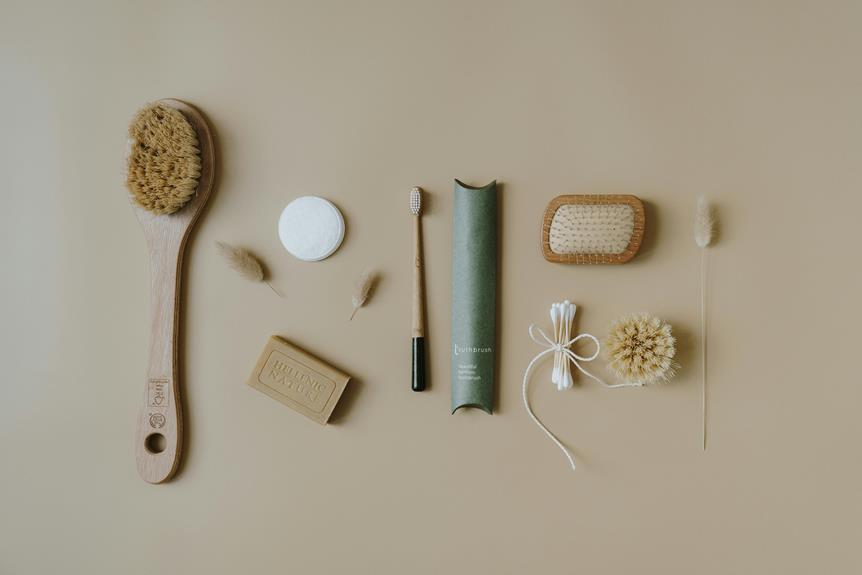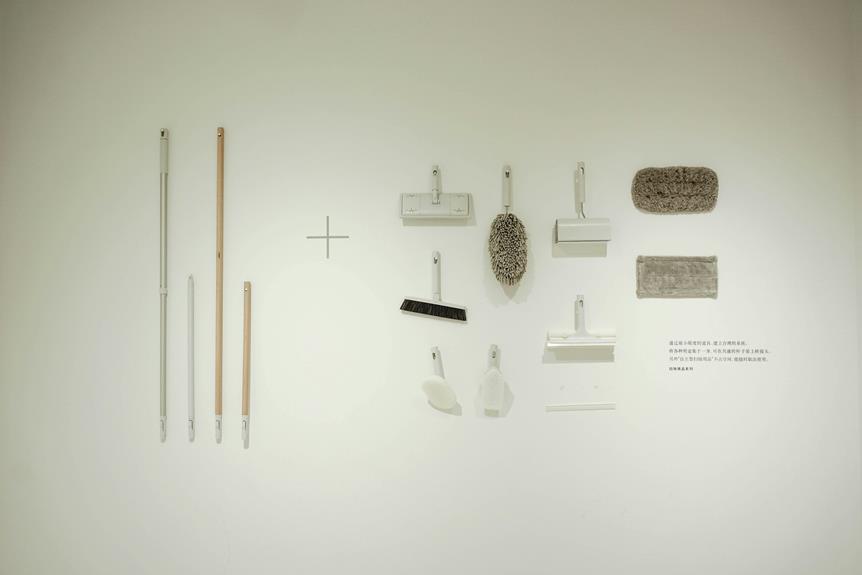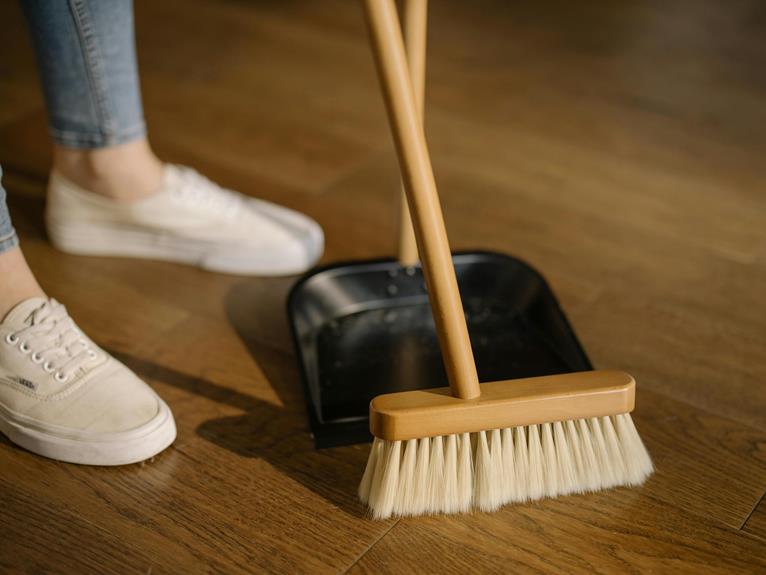As I open the windows and let the warm breeze clear away the last traces of winter, I am reminded that it’s time for a thorough seasonal cleaning.
Every year, as the seasons change, I take comfort in the rhythmic ritual of decluttering, organizing, and refreshing my living space. There is a great sense of satisfaction that comes with transforming a messy room into a pristine haven.
But deep seasonal cleaning goes beyond just a chore; it presents an opportunity for a fresh start, a chance to breathe new life into our surroundings.
In the paragraphs ahead, I will share my insights and strategies for mastering this timeless art, from practical tips on decluttering and organizing to maintaining a clean and healthy indoor environment.

The Importance of Deep Seasonal Cleaning
Deep seasonal cleaning is an essential task that shouldn’t be overlooked. As someone who values a clean and organized home, I understand the importance of regular cleaning and the benefits it brings to our living spaces. When we dedicate time to deep seasonal cleaning, we not only create a more inviting and welcoming environment but also promote a sense of belonging within our homes.
Regular cleaning is crucial for maintaining a healthy and hygienic living space. Over time, dust, dirt, and allergens can build up, leading to respiratory issues and allergies. By thoroughly cleaning our homes each season, we can eliminate these potential health hazards, ensuring a safer environment for ourselves and our loved ones.
A clean home also provides numerous benefits beyond physical health. It promotes mental well-being by reducing stress and anxiety. When our surroundings are clutter-free and organized, it creates a calming atmosphere that allows us to relax and unwind. A clean home fosters productivity and focus. For instance, a clutter-free workspace can enhance our ability to concentrate and be more efficient in our tasks.
Furthermore, a clean home is a source of pride and satisfaction. When we invite friends and family into our well-maintained living space, it creates a sense of belonging and community. It shows that we care about our environment and the comfort of our loved ones, fostering stronger bonds and creating lasting memories.
Creating a Cleaning Schedule
To effectively manage my cleaning tasks, I find it helpful to create a cleaning schedule. Having a schedule not only helps me stay on track, but also ensures that all areas of my home are thoroughly cleaned.
Here are four organizing techniques that I use to create an effective cleaning schedule:
- Assess the cleaning needs: Before creating a schedule, I evaluate the specific cleaning tasks that need to be done. I make a list of all the areas in my home that require attention and identify any special cleaning projects that need to be tackled.
- Prioritize tasks: Once I have a comprehensive list of cleaning tasks, I prioritize them based on urgency and importance. I consider factors such as how often a particular area is used or if there are any allergens present to determine which tasks should be done first.
- Assign specific days or time slots: To ensure that I stay consistent with my cleaning routine, I assign specific days or time slots for each task. For example, I might designate Mondays for deep cleaning the bathrooms and Fridays for vacuuming and dusting.
- Be flexible and adaptable: While having a schedule is essential, it’s equally important to be flexible and adaptable. Life can be unpredictable, and unexpected events may arise. If I’m unable to complete a task on its assigned day, I simply reschedule it for another day without feeling overwhelmed.
Decluttering and Organizing Tips
Maintaining a tidy living space is easier when you follow some decluttering and organizing tips. These strategies can help create a sense of peace and order in your home while maximizing your space’s functionality.
To start decluttering, it’s important to have a clear vision of how you want your home to look and feel. Visualize the desired outcome to stay focused and motivated. Begin by sorting your belongings into three groups: keep, donate, and discard. Be decisive and let go of items that no longer serve a purpose or bring you joy.
Once you’ve decluttered, it’s time to organize. Create designated spaces for each category of items. Invest in storage solutions like bins, baskets, and shelves to keep things organized and easily accessible. Utilize vertical space by installing hooks or racks for coats, bags, or hats. Labeling containers and shelves can also help maintain an organized system.
Remember to regularly reassess your belongings and reorganize them as needed. Set aside time each month to declutter and organize specific areas to prevent clutter from building up again. By implementing these strategies, you can create a tidy and inviting living space that promotes a sense of peace and belonging.
Tackling the Kitchen: From Appliances to Cabinets
Now that you’ve successfully organized the rest of your home, it’s time to focus on the kitchen. The kitchen is the heart of the home, so it’s important to keep it clean and organized. Here are four important tasks to tackle when deep cleaning your kitchen:
- Maintaining your appliances: Start by giving your appliances some much-needed care. Clean your oven by removing any burnt-on food and wiping down the interior. Don’t forget to clean the stovetop and range hood as well. For your refrigerator, empty it and wipe down the shelves and drawers. Check the expiration dates of your condiments and throw away anything that’s gone bad. Lastly, run a cleaning cycle on your dishwasher to remove any built-up grime.
- Organizing your cabinets: Take a look at your kitchen cabinets and assess their organization. Start by emptying them and wiping down the shelves. Donate or get rid of any items that you no longer need or use. Consider using storage containers or dividers to keep your cabinets tidy. Group similar items together for easy access. Take the time to organize your spices, pantry items, and cookware in a way that makes sense to you. This won’t only make cooking more efficient but will also create a sense of pride in your kitchen.
- Deep cleaning your sink: Your kitchen sink can harbor bacteria and food particles. Start by clearing out any dishes and debris. Then, scrub the sink with a mixture of baking soda and vinegar to remove stains or odors. Don’t forget to clean the faucet and handles as well. Finally, pour boiling water down the drain to sanitize it.
- Freshening up your countertops: Clear off your countertops and wipe them down with a mild cleaning solution. Remove any stains or spills and give them a good scrub. Consider using countertop organizers or baskets to keep clutter at bay and maintain tidy surfaces. Add a fresh bouquet or a scented candle to create a welcoming and cozy atmosphere.
Deep Cleaning the Bathroom: From Tiles to Grout
It’s time to give your bathroom a thorough cleaning, focusing on the tiles and grout. Deep cleaning of the bathroom requires specific techniques to achieve a sparkling clean space. One crucial aspect is removing tough stains from the tiles and grout.
To begin, gather the necessary supplies: a high-quality tile and grout cleaner, a scrub brush or toothbrush, a sponge, and clean water. Apply the tile and grout cleaner to the stained areas, following the instructions on the label. Allow the cleaner to sit for a few minutes, allowing it to penetrate the stains.
Use a scrub brush or toothbrush to scrub the tiles and grout in a circular motion. Apply some pressure to effectively clean the grout lines and remove any built-up dirt or grime. Pay extra attention to areas with tough stains. Rinse the brush or toothbrush frequently to remove loosened dirt or grime.
After scrubbing, use a sponge or clean cloth to wipe away any residue. Rinse the sponge or cloth frequently to ensure complete removal of the cleaner and dirt. Repeat this process until the tiles and grout are clean and free of stains.
Deep cleaning of the bathroom, particularly the tiles and grout, can be time-consuming. However, by using these techniques and persistently tackling tough stains, you can transform your bathroom into a fresh and inviting space.
Reviving Your Living Spaces: Furniture and Carpets
Now let’s focus on reviving your furniture and carpets in your living spaces. This step is important in creating a warm and inviting atmosphere that reflects your style.
Here are four essential tips to help you revive your furniture and carpets:
- Bring life back to old upholstery:
- Over time, upholstery can become worn and faded.
- Start by giving it a thorough cleaning.
- Vacuum the surface to remove dust and dirt particles.
- Use a suitable upholstery cleaner to remove stains and refresh the fabric.
- If the upholstery needs more extensive repair, consider reupholstering or adding slipcovers for a fresh new look.
- Keep your area rugs clean:
- Area rugs not only add warmth and texture to your living spaces but also trap dirt and allergens.
- To effectively clean them, start by vacuuming both sides to remove loose dirt.
- Spot clean any stains using a mild detergent or carpet cleaner.
- For a deeper clean, you can steam clean or hire a professional rug cleaner.
- Make sure to let the rug dry completely before placing it back in your living space.
- Restore the shine of your wooden furniture:
- Over time, wooden furniture can lose its luster.
- To revive it, dust the surface with a soft cloth or microfiber duster.
- Apply a furniture polish or wax to restore the natural beauty of the wood.
- Follow the manufacturer’s instructions and test the product on a small, inconspicuous area before applying it to the entire piece.
- Eliminate odors and freshen the air:
- Unpleasant odors can develop in our living spaces.
- Combat them by sprinkling baking soda on carpets and upholstery, letting it sit for a few hours, and then vacuuming it up.
- You can also freshen the air by using natural air purifiers like essential oil diffusers or placing bowls of vinegar around the room.
Effective Techniques for Dusting and Vacuuming
To effectively remove dust and dirt from your living spaces, it’s important to use efficient techniques for dusting and vacuuming. Deep cleaning your home requires more than just a quick swipe with a feather duster. It requires a systematic approach and the right tools to ensure that every nook and cranny is thoroughly cleaned.
When dusting, start from the top and work your way down. This prevents dust from settling on already-cleaned surfaces. Use a microfiber cloth or a soft duster to gently wipe away the dust. Remember to focus on often overlooked areas like ceiling fans, light fixtures, and baseboards. For hard-to-reach places, use an extendable duster or wrap a cloth around the end of a broom.
Vacuuming is another crucial step in deep cleaning. Start by removing any small objects or debris from the floor to prevent the vacuum cleaner from getting clogged. Use the appropriate attachments for different surfaces, such as a brush attachment for upholstery and a crevice tool for corners and edges. Make sure to move furniture and vacuum underneath to get rid of hidden dust and dirt.
In addition to regular vacuuming, consider investing in a high-quality air purifier to further improve the air quality in your home. This will help capture airborne particles and allergens, making your living spaces cleaner and healthier.
Refreshing Bedrooms: Mattresses and Linens
Now let’s focus on refreshing your bedrooms by giving some attention to your mattresses and linens. These four essential tips will help you achieve a clean and organized bedroom:
- Assess your mattress: Start by evaluating the condition of your mattress. Is it still comfortable and providing the support you need for a good night’s sleep? If not, it might be time to consider investing in a new one. Look for a mattress that suits your sleeping style and ensures proper spinal alignment. Remember, a good mattress is crucial for a restful sleep.
- Clean your mattress: Once you’ve found the right mattress, it’s important to keep it clean. Vacuum the surface to remove any dust or debris, then spot-clean any stains using a mild detergent and warm water. To freshen up your mattress, sprinkle it with baking soda, let it sit for a few hours, and then vacuum it again. This will eliminate odors and leave your mattress smelling fresh.
- Wash your linens: Clean and fresh linens can make a big difference in the overall feel of your bedroom. Regularly wash your sheets, pillowcases, and duvet covers using a gentle detergent. Don’t forget to check the care instructions for any specific washing recommendations. After washing, hang them out to dry in the sun for a natural fresh scent.
- Organize your bedroom: A clutter-free bedroom promotes relaxation and better sleep. Take the time to declutter and organize your space. Use storage solutions like baskets, bins, or under-bed storage to keep your belongings neatly tucked away. Consider implementing a regular cleaning routine to maintain a tidy and inviting bedroom environment.
Taking Care of Windows and Curtains
Now let’s talk about how to keep your windows and curtains in great condition. Taking care of them is important for maintaining a clean and inviting living space. Clean windows allow more natural light inside and provide a clear view of the outside world. Well-maintained curtains add elegance and warmth to any room.
To help you with this, here’s a simple guide on cleaning blinds and washing curtains.
Cleaning blinds can be a bit tedious, but with the right approach, it can be done effectively. Start by dusting the blinds using a microfiber cloth or feather duster. For a deeper clean, you can use a mixture of warm water and mild dish soap. Gently wipe each slat to remove dirt and grime. Rinse the blinds with clean water and let them air dry before closing them.
Washing curtains is another important step in keeping your home fresh. Before washing, check the care label to see if your curtains are machine washable. If they are, remove any hooks or hardware and place them in a laundry bag for protection. Use a gentle cycle and cold water to prevent shrinkage or damage. Hang the curtains back up while they’re slightly damp to minimize wrinkles.
Maintaining a Clean and Healthy Indoor Environment
To ensure a clean and healthy indoor environment, follow these four simple steps:
- Choose eco-friendly cleaning supplies: When it comes to keeping our indoor environment clean, it’s important to use products that are free from harsh chemicals and toxins. Opt for eco-friendly cleaning supplies that not only protect our health and the environment but also make cleaning safer and more pleasant.
- Regularly clean high-touch surfaces: High-touch surfaces like doorknobs, light switches, and countertops can harbor germs and bacteria. Make it a habit to clean these areas regularly with disinfecting wipes or a water and vinegar solution. This simple step helps prevent the spread of illnesses and keeps your indoor environment healthy.
- Maintain a consistent cleaning schedule: Consistency is key to maintaining a clean and healthy indoor environment. Set specific days or times each week to tackle different cleaning tasks, such as dusting, vacuuming, and mopping. By following a regular cleaning schedule, you’ll stay on top of dirt, dust, and allergens, ensuring a cleaner and healthier living space.
- Practice good ventilation: Proper ventilation is essential for a clean and healthy indoor environment. Open windows and doors regularly to let fresh air circulate throughout your home. This helps remove stale air, odors, and pollutants, promoting better indoor air quality.
Cleaning Outdoor Spaces: Patios and Porches
Let’s talk about keeping your outdoor spaces, like patios and porches, clean and inviting. As the weather gets warmer, we all want to spend more time outdoors, so it’s important to maintain a clean environment.
One aspect of outdoor cleaning is taking care of your outdoor furniture. Over time, it can gather dirt, dust, and even mildew.
To clean your furniture, start by using a broom or brush to remove any loose debris. Then, make a solution of mild dish soap and warm water and use a sponge or soft cloth to gently scrub the surfaces. Rinse well with water and let the furniture dry completely before using it again.
Aside from furniture, it’s also important to tackle any stains on your outdoor surfaces. Whether it’s food or drink spills, or just everyday wear and tear, stains can make your patio or porch look messy.
To remove organic stains like food or grass, a mixture of vinegar and water usually does the trick. Simply spray the solution onto the stain, let it sit for a few minutes, and then scrub with a brush or cloth.
For tougher stains like oil or grease, you may need a commercial stain remover or degreaser. Follow the instructions carefully and test it on a small, inconspicuous area first to avoid any damage.
Storing and Preserving Seasonal Items
Storing and preserving seasonal items is crucial for maintaining an organized living space. It helps maximize storage space and keeps our belongings in good condition for future use. Here are four tips to effectively store and preserve seasonal items:
- Store Seasonal Clothing: When transitioning between seasons, clean and dry your clothing before packing it away. Use sturdy plastic bins or vacuum-sealed bags to protect them from moisture, dust, and pests. Label each container with the contents and store them in a cool, dry place like a closet or under the bed.
- Preserve Holiday Decorations: Holiday decorations hold sentimental value and are often used once a year. To keep them in good condition, wrap delicate ornaments in tissue paper or bubble wrap before storing them in clear plastic bins. Store these bins in a designated area like the attic or basement, away from direct sunlight and extreme temperatures. Label them for easy retrieval next year.
- Organize Seasonal Sports Equipment: For outdoor activities that vary with the seasons, use hooks, racks, or designated bins to store sports equipment such as skis, snowboards, bicycles, or kayaks. Clean and inspect them before storing to prevent damage. Hang or stack them in a secure area like the garage or shed for easy accessibility when the season comes around again.
- Handle Seasonal Electronics Properly: Some seasonal items like air conditioners or heaters require proper storage to maintain functionality. Clean and remove any dust or debris before storing them. Keep them in their original packaging or use dust covers to protect them from scratches and damage. Store these electronics in a dry and temperature-controlled area, like a storage closet, so they’re ready for use when needed.
Conclusion
As I put the finishing touches on my thorough seasonal cleaning, I can’t help but feel a sense of accomplishment and satisfaction.
The gleaming windows, well-organized cabinets, and rooms filled with a fresh scent make all the hard work worthwhile.
However, there’s still one more task to complete – storing and preserving seasonal items. With excitement building, I carefully pack away the decorations and summer gear, knowing that when the time comes, they’ll once again bring joy and evoke cherished memories.










